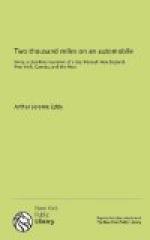Who would recognize classic Menotomy in the tinsel ring of Arlington? The good old Indian name, the very speaking of which is a pleasure, has given place to the first-class apartments, —steam-heated, electric-lights, hot and cold water, all improvements —in appellations of Arlington and Arlington Heights. A tablet marks the spot where on April 19 “the old men of Menotomy” captured a convoy of British soldiers. Poor old men, once the boast and glory of the place that knew you; but now the passing traveller curiously reads the inscription and wonders “Why were they called the old men ’of Menotomy’?” for there is now no such place.
Massachusetts Avenue—Massachusetts Avenue! there’s a name, a great, big, luscious name, a name that savors of brown stone fronts and plush rockers: a name which goes well with the commercial prosperity of Boston. Massachusetts Avenue extends from Dorchester in Boston to Lexington Green; it has absorbed the old Cambridge and the old Lexington roads; the old Long Bridge lives in history, but, rechristened Brighton Bridge, the reader fails to identify it.
Concord remains and Lexington remains, simply because no real estate boom has yet reached them but Bunker Hill, there is a feeling that apartments would rent better if the musty associations of the spot were obliterated by some such name as “Buckingham Heights,” or “Commonwealth Crest;” “The Acropolis” has been prayerfully considered by the freemen of the modern Athens;— whatever the decision may be, certain it is the name Bunker Hill is a heavy load for choice corners in the vicinity.
There are a few old names still left in Massachusetts,— Jingleberry Hill and Chillyshally** Brook sound as if they once meant something; Spot Pond, named by Governor Winthrop, has not lost its birthright; Powder-Horn Hill records its purchase from the Indians for a hornful of powder—probably damp; Drinkwater River is a good name,—Strong Water Brook by many is considered better. It is well to record these names before they are effaced by the commercialism rampant in the suburbs of Boston.
At the Town Hall in Lexington we turned to the right for East Lexington, and made straight for Follen Church, and the home of Dr. Follen close by, where Emerson preached in 1836 and 1837.
The church was not built until 1839. In January, 1840, the congregation had assembled in their new edifice for the dedication services. They waited for their pastor, who was expected home from a visit to New York, but the Long Island Sound steamer—Lexington, by strange coincidence it was called—had burned and Dr. Follen was among the lost. His home is now the East Lexington Branch of the Public Library.




